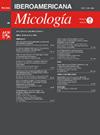引起念珠菌病的念珠菌种类的转移:一项来自大学医院的7年研究和对严格意义上的假丝菌病兴起的评估。
IF 1.6
4区 生物学
Q4 MYCOLOGY
引用次数: 0
摘要
背景:念珠菌是卫生保健机构中第四大流行感染。值得注意的是,非白色念珠菌和念珠菌种类,特别是假丝酵母菌,近年来在世界范围内作为念珠菌的病原体有所增加。目的:本研究旨在评估假丝酵母菌引起的假丝酵母菌的患病率和抗真菌敏感性随时间的变化,同时调查分离株之间的克隆关系。方法:对2016年1月至2022年12月期间发生的念珠菌发作病例进行菌种分析。MALDI-TOF MS在种水平上对念珠菌分离物进行鉴定,并通过限制性片段长度多态性方法对C. parapsilosis复合体内的种进行鉴定。氟康唑药敏试验遵循EUCAST指南。采用AP-PCR、REA-PFGE和电泳核型分析三种方法,对拟裂菇分离株间的克隆关系进行了评价。结果:在7年的时间里,所有血培养中念珠菌的患病率为2.1%(679例)。最常见的念珠菌种为假丝酵母菌(33.7%)、白色念珠菌(32.7%)、光秃中丝酵母菌(14.4%)和热带假丝酵母菌(8%)。值得注意的是,从2016年到2022年,parapsilosis的分离率逐年上升。随着时间的推移,假僵菌对氟康唑的敏感性逐渐下降,从2016年的100%下降到2022年的72.6%。电泳核型在克隆亲缘分析中表现出较强的差异性(D=0.9875)。结论:我们的研究结果表明,在研究期间,严格意义上的假蝇对氟康唑的耐药性呈上升趋势。电泳核型已成为一种评估克隆关系的可靠方法。虽然没有发现显性暴发分离物,但高聚类率表明,在未来,副吸虫病有可能成为一种重要的医院感染因子。本文章由计算机程序翻译,如有差异,请以英文原文为准。
Shift in Candida species causing candidemia: A seven-year study from a university hospital and evaluation of the rise of Candida parapsilosis sensu stricto
Background
Candidemia ranks the fourth most prevalent infection in healthcare settings. Notably, non-Candida albicans Candida species, particularly Candida parapsilosis, have experienced a worldwide increase as causative agents of candidemia in recent years.
Aims
This study aimed to assess shifts in prevalence and antifungal susceptibility of C. parapsilosis among candidemia-causing species over time, alongside investigating clonal relationships among isolates.
Methods
We analyzed Candida species in candidemia episodes from January 2016 to December 2022. MALDI-TOF MS identified Candida isolates at the species level, and the identification of the species within C. parapsilosis complex was achieved via the restriction fragment length polymorphism method. Fluconazole susceptibility testing followed EUCAST guidelines. Clonal relationships among C. parapsilosis isolates were assessed using three methods: AP-PCR, REA-PFGE, and electrophoretic karyotyping.
Results
Across a seven-year period, Candida prevalence among all blood cultures was 2.1% (679 cases). The most prevalent Candida species were C. parapsilosis (33.7%), C. albicans (32.7%), Nakaseomyces glabratus (formerly Candida glabrata) (14.4%), and Candida tropicalis (8%). Notably, C. parapsilosis isolation rates increased annually from 2016 to 2022. Fluconazole susceptibility of C. parapsilosis isolates declined over time, with rates decreasing from 100% in 2016 to 72.6% in 2022. Electrophoretic karyotyping exhibited superior discrimination in clonal relationship analysis (D = 0.9875).
Conclusions
Our findings highlight a concerning trend of increasing fluconazole resistance in C. parapsilosis sensu stricto over the study period. Electrophoretic karyotyping has emerged as a robust method for assessing clonal relationships. While no dominant outbreak isolate was identified, the high clustering rate suggests the potential of C. parapsilosis as a significant nosocomial infection agent in the future.
求助全文
通过发布文献求助,成功后即可免费获取论文全文。
去求助
来源期刊

Revista Iberoamericana De Micologia
MYCOLOGY-
CiteScore
1.90
自引率
0.00%
发文量
17
审稿时长
81 days
期刊介绍:
Revista Iberoamericana de Micología (Ibero-American Journal of Mycology) is the official journal of the Asociación Española de Micología, Asociación Venezolana de Micología and Asociación Argentina de Micología (The Spanish, Venezuelan, and Argentinian Mycology Associations). The Journal gives priority to publishing articles on studies associated with fungi and their pathogenic action on humans and animals, as well as any scientific studies on any aspect of mycology. The Journal also publishes, in Spanish and in English, original articles, reviews, mycology forums, editorials, special articles, notes, and letters to the editor, that have previously gone through a scientific peer review process.
 求助内容:
求助内容: 应助结果提醒方式:
应助结果提醒方式:


